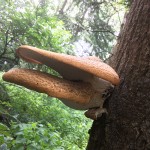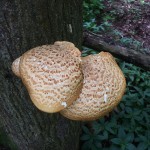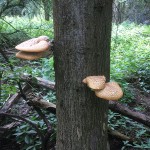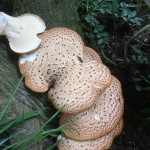Dryad’s saddle
Polyporus Squamosus
COMMON NAME: Dryad’s saddle, Pheasant back, Pheasant mushroom
SCIENTIFIC NAME: Polyporus Squamocus
EDIBLE: YES
Description
This is a relative common mushroom and very easy to spot due to its size from 5cm to 60cm across and fan shaped with a cream upper surface covered in brown scales, like the plumage of a hen pheasant, hence the name. The underside is made up of pores and the flesh is white when young, smelling of melon. The stem is large, sometimes up to 8 cm and blackish towards the base and can be found from April to August.
Spore print: White Ellipsoid
Habitat
This is a parasitic mushroom and is usually found on deciduous trees and stumps, Elm, Sycamore and Beech in particular.
Uses
This is a nice nutty tasting mushroom with a good texture when young. It gets very tough as it ages, younger specimens are best to gather. I leave any that are bigger than my hand. They can be dried and powdered for stock or sliced and fried.
Other Facts
These mushrooms can grow so big. They obtained the name Dryads Saddle from Greek mythology. A Dryad is a tree nymph or tree spirit especially of the oak tree. Drys means Oak in Greek.




